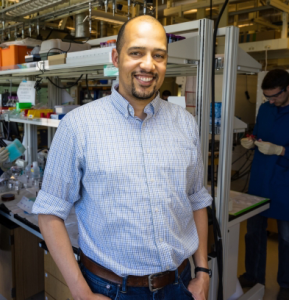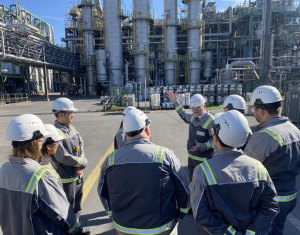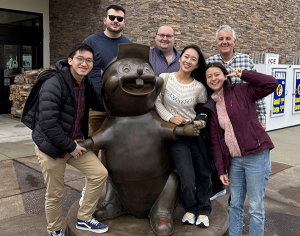August 21, 2025
Brushett will lead one-of-its-kind program that has been a bridge between education and industry for over a century
 Fikile R. Brushett, Ralph Landau Professor of Chemical Engineering Practice, has been named director of the David H. Koch School of Chemical Engineering Practice, effective July 1, 2025. In this role, Brushett will lead one of MIT’s most innovative and distinctive educational programs.
Fikile R. Brushett, Ralph Landau Professor of Chemical Engineering Practice, has been named director of the David H. Koch School of Chemical Engineering Practice, effective July 1, 2025. In this role, Brushett will lead one of MIT’s most innovative and distinctive educational programs.
Brushett joined the chemical engineering faculty in 2012 and has been a deeply engaged member of the department. An internationally recognized leader in the field of energy storage, his research advances the science and engineering of electrochemical technologies for a sustainable energy economy. He is particularly interested in the fundamental processes that define the performance, cost, and lifetime of present-day and next-generation electrochemical systems. In addition to his research, Brushett has served as a first year undergraduate advisor, as a member of the department’s graduate admissions committee and on MIT’s Committee on the Undergraduate Program.
“Fik’s scholarly excellence and broad service position him perfectly to take on this new challenge,” says Kristala L. J. Prather, Arthur D. Little Professor and head of the Chemical Engineering Department. “His role as Practice School director reflects not only his technical expertise, but his deep commitment to preparing students for meaningful, impactful careers. I’m confident he will lead the Practice School with the same spirit of excellence and innovation that has defined the program for generations.”
Brushett succeeds T. Alan Hatton, Ralph Landau Professor of Chemical Engineering Practice, Post-Tenure, who directed the Practice School for 36 years. For many, Hatton’s name is synonymous with the program. When he became director in 1989, only a handful of major chemical companies hosted stations.
“I realized that focusing on one industry segment was not sustainable and did not reflect the breadth of a chemical engineering education,” Hatton recalls. “So I worked to modernize the experience for students and have it reflect the many ways chemical engineers practice in the modern world.”
Under Hatton’s leadership, the Practice School expanded globally and across industries, providing students with opportunities to work on diverse technologies in a wide range of locations. He pioneered the model of recruiting new companies each year, allowing many more firms to participate while also spreading costs across a broader sponsor base. He also introduced an intensive, hands-on project management course at MIT during IAP, which has become a valuable complement to students’ station work and future careers.
Value for students and industry
The Practice School benefits not only students but also the companies that host them. By embedding teams directly into manufacturing plants and R&D centers, businesses gain fresh perspectives on critical technical challenges, coupled with the analytical rigor of MIT-trained problem solvers. Many sponsors report that projects completed by Practice School students have yielded measurable cost savings, process improvements, and even new opportunities for product innovation.
For manufacturing industries, where efficiency, safety, and sustainability are paramount, the program provides actionable insights that help companies strengthen competitiveness and accelerate growth. The model creates a unique partnership: students gain true real-world training, while companies benefit from MIT expertise and the creativity of the next generation of chemical engineers.
|
|
|
A century of hands-on learning
Founded in 1916 by MIT chemical engineering alumnus Arthur D. Little and professor William Walker, with funding from George Eastman of Eastman Kodak, the Practice School was designed to add a practical dimension to chemical engineering education. The first five sites—all in the Northeast—focused on traditional chemical industries working on dyes, abrasives, solvents, and fuels.
Today, the program remains unique in higher education. Students consult with companies worldwide across fields ranging from food and pharmaceuticals to energy and finance, tackling some of industry’s toughest challenges. More than a hundred years after its founding, the Practice School continues to embody MIT’s commitment to hands-on, problem-driven learning that transforms both students and the industries they serve.
The Practice School experience is part of the Chemical Engineering Department’s MSCEP and PhD/ScDCEP programs. After coursework for each program is completed, the student attends Practice School stations at host company sites. A group of six to ten students spends two months each at two stations; each station experience includes teams of two or three students working on a month-long project, where they will prepare formal talks, scope of work, and a final report for the host company. Recent stations include Evonik in Marl, Germany; AstraZeneca in Gaithersburg, Maryland; EGA in Dubai, UAE; AspenTech in Bedford, Massachusetts; and Shell Technology Center and Dimensional Energy in Houston, Texas.
Hatton’s legacy and research will be celebrated at this fall’s AIChE Annual Meeting in Boston with a symposium organized by his colleagues and former students. Click here for more information.



